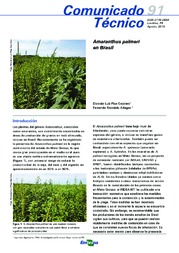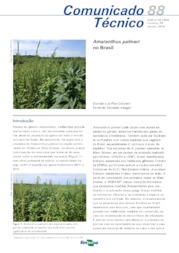 Busca de Projetos
Busca de Projetos
Identification and mapping of herbicide-resistant weeds in the South, Southeast and Midwest

Photo: IKEDA, Fernanda Satie
Brazil is a tropical country with an extensive territorial area and vast plant diversity. This makes the weed species that infest the crops be widely varied. Such characteristics differentiate Brazil from other countries with temperate climates. GM crops that are resistant to herbicides, especially to glyphosate, have created a new scenario for weed control in Brazilian agriculture. Farmers have adopted RR technology right away as efficiency and cost are its main benefits. The use of glyphosate has become generalized in farms all over Brazil. The repeated use of glyphosate has given rise to cases of weed resistance to this herbicide in different places of the country. The launch of glyphosate resistant maize has further increased the use of this molecule. The new technologies in development by Bayer (Liberty Link) and Dow AgroScience (Enlist) are also based on the use of glyphosate associated with one or two herbicidal mechanisms such as 2,4-D or ammonium-glufosinate. In this scenario, there is going to be an increase in the use of glyphosate, and it will be necessary to enforce the adoption of crop rotation and succession of glyphosate resistant crops. Glyphosate resistant Lolium, Conyza and Digitaria species have already been identified in Brazil and constitute serious problems in the soybean, maize, cotton, and sugarcane plantations and in citrus and apple orchards. The last event of impact in the area of herbicide resistance was the identification, in the state of Mato Grosso, in June 2015, of the weed Amaranthus palmeri, a species that did not previously exist in Brazil, and is responsible for making soybean and maize cultivation impracticable in areas of the U.S. and for causing “panic” among technicians and companies in the area. The solution, in the US, occurred in 2013, with the launch of the Liberty Link soybean by Bayer in that country. Thus, it is necessary to monitor Amaranthus palmeri as well as other resistant species with regard to their dispersion, and assess management alternatives. In order to keep the problem of resistant weeds from rendering resistant crop technology unviable in Brazil, the performance of monitoring and the definition of management alternatives is of utmost importance. Thus, the goals of this project are: regionally locating (mapping) where the foci of the occurrence of the resistance of species such as Lolium, Conyza, Eleusine, Euphoria and Digitaria are; identifying new resistant species that occur in Brazil; establishing prevention, management and control strategies for the resistant species identified in Brazil. To reach this goal, in addition to a managerial Action Plan, the project comprises four technical-scientific plans. The dissemination of results will occur through lectures, congresses and publication in national and international scientific journals. Finally, the innovation of this project lies in anticipating scenarios related to weed dynamics and in the definition of strategies of prevention, management and control for the cases of introduction of new species, such as the case of A. palmeri, and the selection of resistant species, establishing protocols and solutions for cases of difficult solution before they happen. It is worth pointing out that this project is an expansion of Stage I, which especially focused on the states of Rio Grande do Sul and Santa Catarina, for the Southeast and Midwest regions of Brazil, associated with the increase in actions in the Southern portion of Rio Grande do Sul.
Ecosystem: Cerrados Region
Status: Completed Start date: Tue Sep 01 00:00:00 GMT-03:00 2015 Conclusion date: Sun Dec 31 00:00:00 GMT-03:00 2017
Keywords: Manejo vegetação, Controle químico, Competição


